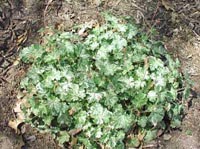Resource Library
Plant of the Week: Coralbells
The University of Arkansas System Division of Agriculture does not promote, support or recommend plants featured in "Plant of the Week." Please consult your local Extension office for plants suitable for your region.
Plant of the Week
Coralbells
Latin: Heuchera sanguinea

Mass merchants have flourished using the 80/20 rule. Their premise has been that 80 percent of sales is generated by 20 percent of the merchandise on their shelves, so by carefully stocking the high demand items both volume and profits can be increased.
Using this mass appeal approach, everything from the cars we drive to the toothpaste by the sink becomes more homogenized.
The 80/20 principle holds true in the plant world too, and I’ve been intrigued by what forces pigeonhole a plant into the high demand or also-run category. Coralbells (Heuchera sanguinea) has long languished in the also-run category, but renewed interest seems to be pushing it towards greater popularity. One might logically ask why?
Coralbells is a member of the saxifrage family and is native to the mountains of New Mexico and Arizona. It is an herbaceous, evergreen perennial that forms clumps to 16 inches across but less than 8 inches in height. Its leaves are about 2 inches across, rounded, toothed and borne on 4-inch long petioles. Most selections have mottled, gray-green leaves that vaguely resembles that of a geranium.
My personal favorite amongst the coralbells is a cultivar called Snow Angel. It has the characteristics of the typical coralbells except the foliage is white-variegated, producing an effective display even when the plant is not in bloom.
In late spring, coralbells produces 18-inch tall, open panicles bearing an array of dainty, bell-shaped flowers about the size of a pea. The Latin epitaph - sanguinea - translates as blood, the typical flower color of the species. Breeders have extended the normal red flower color to pink, coral and white forms. Plants remain in bloom until early summer.
The path coralbells took from the wilds of the American West to gardens throughout the world is uncertain, but it seems likely to have been gathered into the fold by Europeans who began growing rock garden plants in the 1880s. By the turn of the 20th century, it was well known in the horticultural literature.
But, though it was offered, coralbells became neither rich nor famous. As one writer put it, the plant is "in all respects an unassuming, pleasing plant." Yikes! Unassuming - the kiss of death in the popularity poll of life.
But we are here to save the day. The Arkansas Green Industry Association and University of Arkansas Cooperative Extension Service have selected Heuchera as one of the Arkansas Select plants for 2003. Plant breeders, lead by Oregon nurseryman Dan Heims, have been busy little bees in recent years producing upwards of a hundred new Heuchera hybrids.
These hybrids have been mass produced in tissue culture and a bevy of these new garden gems await you at your local garden center or nursery. For a comprehensive look at the Arkansas Select plants, visit the Arkansas Extension Home and Garden website at
Coralbells are easy to grow in any moderately rich garden soil. In the garden, they are best situated in light shade or in full sun if protected from the scorching heat of late afternoon.
While they have good drought tolerance, some attention to watering will give better garden performance. A topdressing with fertilizer in the spring encourages robust plant size.
If left unattended for many years, coralbells will begin getting smaller and smaller, eventually disappearing completely. To avoid this, lift and dive the plants every three to five years and replenish the site with fresh compost.
By: Gerald Klingaman, retired
Extension Horticulturist - Ornamentals
Extension News - April 18, 2003
The University of Arkansas System Division of Agriculture does not maintain lists of retail outlets where these plants can be purchased. Please check your local nursery or other retail outlets to ask about the availability of these plants for your growing area.